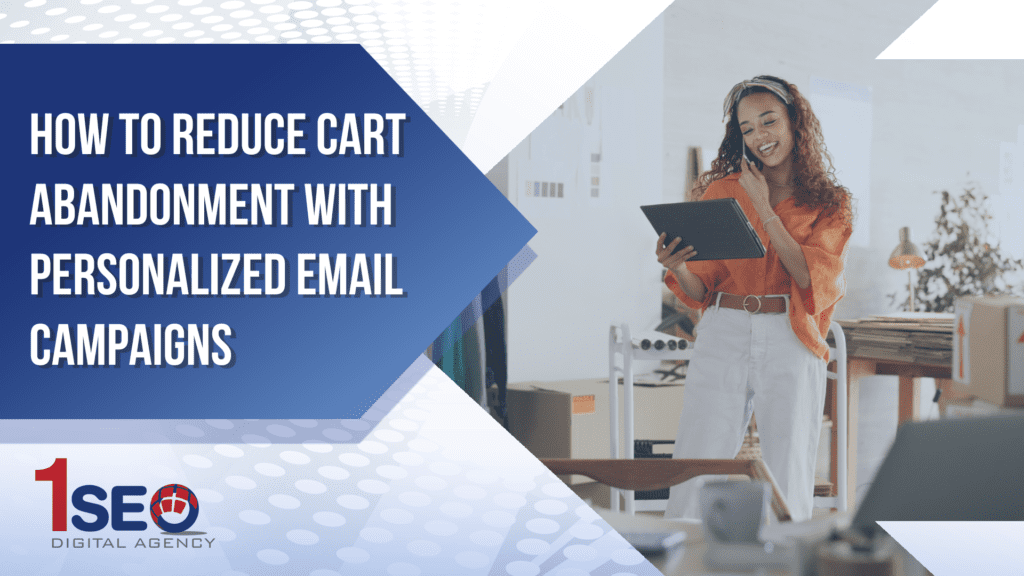Speak To An Expert Now: 215-946-1046
Why Social Media is the New Dada Art Movement
Those who say history repeats itself are not wrong, especially if they are talking about art history. With infamous pieces such as The Fountain by

Cart abandonment is one of the most significant challenges facing direct‑to‑consumer ecommerce brands today. High shopping cart abandonment rates can undermine revenue, distort conversion rate optimization efforts, and erode brand loyalty. With consumers accustomed to seamless online experiences, ecommerce companies must harness data, marketing automation, email marketing, and personalization to re‑engage potential buyers and optimize sales performance. This blog article explains how DTC ecommerce retailers can reduce cart abandonment by building powerful, personalized email campaigns within a comprehensive online marketing and customer experience framework.

At its core, cart abandonment occurs when a consumer adds a product to the shopping cart but leaves the site before completing checkout. The reasons behind abandonment include price concerns, unexpected shipping fees, complicated payment or credit card input, slow web design, lack of trust, or distractions. Understanding this phenomenon begins with market research, customer experience analysis, and exploration of your target audience behaviors. Tools like Google Analytics, ecommerce content marketing metrics, and CRM software provide information on where drop‑off happens in the conversion funnel or sales funnel.
Further research into your target market segmentation and site visitation data reveals patterns: shoppers who exit on the landing page, shopping cart software pages, or payment step. Insights from heat‑mapping, user experience, and web page navigation studies shed light on friction points. What comes out is that personalized retention strategies using email address data and email marketing software are highly effective to intercept abandoned carts.
When a shopper abandons a cart, sending a generic email notification might generate a little traction, but is often ineffective in building customer loyalty, boosting repeat purchases, or enhancing brand awareness. Personalization changes that dynamic. By using dynamic data — products left in cart, customer browsing history, past purchases, loyalty program membership status, and behavioral triggers — brands craft emails that feel relevant, timely, and helpful rather than pushy.
A personalized email marketing campaign based on customer lifetime value, combined with segmentation and market segmentation strategies, allows retrieval of revenue that otherwise slips away. Using marketing automation and the right email marketing services, such campaigns raise revenue, deepening customer relationship management and improving ROI.
Incorporating social proof, testimonials, or influencer marketing endorsements within emails builds credibility. Including coupon codes or incentive offers and strategically timed upselling can boost average order value. Integration with shopping cart software like Shopify, WooCommerce, BigCommerce, Magento, or custom free ecommerce platforms ensures seamless trigger flows tied to cart behavior.
Before launching sophisticated personalized campaigns, the fundamentals must be in place. First, select an email marketing platform that supports automation, segmentation, personalization tokens, responsive web design within emails, analytics, and integration with your ecommerce backend. Platforms such as Klaviyo, Omnisend, Mailchimp, HubSpot, or Shopify’s built‑in email marketing tools offer these capabilities.
Install the appropriate software and integrate with your ecommerce system. Activation of the mailing list and collection of email address data must obey privacy regulation, while ensuring low bounce rate and high deliverability. Ideally, you capture emails when customers log in, subscribe to a newsletter, or start checkout. Once you have captured the email, you segment your target audience based on behavior, cart value, purchase history, loyalty program status, and browsing habits.
In designing an abandoned cart email sequence, begin with a gentle reminder shortly after abandonment. This first email should feel helpful and friendly, referencing the items left behind. Use personalization tokens to include names, product images, or tailored messaging about why these items suit their needs. The tone should support the brand’s unique selling proposition, reinforce customer experience, and offer assistance or reassurance.
If the shopper does not return, follow up with a second email offering added value like a small discount or free shipping incentive. This is where upselling or product bundling suggestions can increase cart size. At each stage, show social proof such as customer testimonials or influencer endorsements to boost trust. Advances in machine learning can trigger smart product recommendations based on browsing data, increasing the likelihood of conversion.
A third email could create urgency—informing the user that items are low in inventory or the coupon expires soon. This email should still feel helpful not aggressive, addressing customer service, ease of checkout, and linking back to the landing page or shopping cart with a clear url and responsive design.
All these emails rely on marketing automation to deliver at optimal timing, personalized and dynamic based on user interactions in real time.
To make abandoned cart campaigns effective, brands must close the loop with analytics. Connect Google Analytics events such as cart addition, checkout initiation, and campaign clicks to your email metrics inside the email marketing platform. Compare baseline conversion rate optimization numbers before and after campaign implementation. Monitor open rates, click‑through rates, conversion rates, and revenue recovered.
Perform A/B testing on subject lines, message copy, coupon amounts, urgency phrasing, timing intervals, and design layouts to refine results. Use bigcommerce, magento, or shopify logs to verify whether shoppers returned and completed checkout or otherwise interacted with further marketing channels like SMS marketing or social media. Leverage search engine visibility data to ensure your product pages are well indexed so that email recipients can revisit them easily via organic search results or Google Shopping listings.
Deep personalization goes beyond referencing the abandoned product. Behavioral segmentation includes prior purchase frequency, categories browsed, total lifetime spend, device used (desktop vs smartphone), geolocation, and referral source. This segmentation can feed into dynamic content blocks: referencing loyalty program status, suggesting complementary products, or highlighting service benefits.
A shopper who often purchases clothing may want styling tips, while one who buys gadgets might look for warranties or accessories. Including influencer marketing posts or social proof relevant to their demographic builds confidence. Sharing short customer testimonials in email content reinforces credibility.
An omnichannel strategy that coordinates email with SMS, social media marketing, and chatbot outreach ensures consistency. If the customer starts checkout on a smartphone and abandons, a well‑timed SMS reminder may complement the email. Each message links back to the same shopping cart so the consumer enjoys a seamless point of sale experience.
Effective abandoned cart recovery is not an isolated tactic. It becomes most powerful when embedded within your broader ecommerce marketing agencies and digital marketing strategy. It aligns with affiliate marketing, referral marketing, influencer marketing, social commerce, and email marketing initiatives promoting your brand and loyalty program.
When users refer friends, one or both parties may receive emails that highlight incomplete purchases. When influencers or affiliates drive traffic, you capture emails and can serve abandoned cart journeys tailored to each referral source. Synchronizing with social media, Google search, and online advertising efforts maximizes brand awareness and visibility across the world wide web and search engine results pages.
Email campaigns also contribute to nurturing long‑term loyalty and customer retention by offering loyalty program rewards, exclusive offers, or early access to new products. Maintaining strong customer support and personalized service within emails enhances customer satisfaction and lifetime value.
Some brands worry about privacy laws or email fatigue. Addressing regulation, you must ensure consent before you send email marketing. Provide opt‑in checkboxes during sign‑up and clear unsubscribe links. Be mindful of spam laws and maintain clean lists. Limit frequency so customers don’t feel inundated.
Technical issues such as improper integration with shopping cart, poor email rendering on devices, or mis‑configured automation can sabotage recovery efforts. Implement responsive web design within emails and test thoroughly on desktop and mobile. Use coupon codes carefully—too many discounts can train shoppers to wait. Each email must reinforce the proposition of convenience, trust, and quality that supports your brand’s reputation.
Consider a retailer using Shopify and Omnisend email marketing software. They installed the automation flow, inserted loyalty point reminders, dynamically pulled in product thumbnails, and triggered email messages 30 minutes, 6 hours, then 24 hours after abandonment. They also tested subject lines referencing price or urgency. As a result, their abandoned cart revenue rose by over 15 percent, the conversion rate optimization efforts paid off, and customer lifetime value increased due to better retention.
Another example: a BigCommerce store integrated with Klaviyo. They segmented users into new visitors versus repeat consumers, and tailored email language accordingly. They added a testimonial and influencer quote within the email, and offered a 10 percent coupon if items remained in cart after 48 hours. They saw not only revenue recovery but improved brand awareness and uplift in referrals.
For companies with more sophisticated technology, machine learning and predictive analytics can forecast which users are most likely to abandon and customize interventions proactively. An ecommerce platform or enterprise software can integrate with API to send dynamic messaging that references real‑time inventory or price. Coupons can be personalized per user, credit card formatting handled smoothly, and bundling offers automatically calculated based on customer preferences.
Cross‑channel coordination raises the impact. Integrating with SMS marketing, chatbot, social commerce channels, and even podcast or infographic content marketing that reminds or retargets shoppers across the internet environment builds familiarity. Using affiliate marketing links, online advertising, and search engine marketing campaigns aligned with the same creative and offers reinforces the messaging across multiple marketing channels.
Reducing cart abandonment yields immediate increases in revenue, but to show ROI, brands must track the money recovered versus the fee or cost of the software, coupon discount cost, and manpower (or outsourcing) used to build campaigns. Use metrics like customer acquisition cost, customer lifetime value, conversion uplift, reduction in abandoned cart rate, and retained customers. Integrate these results into your business model analytics and performance dashboard.
As results improve, scale your campaigns. Expand to cover different market segments, brands, product bundling strategies, cross‑sell flows, and even re‑engage customers with post‑purchase follow‑ups, newsletter invitations, or loyalty program prompts.
As technology evolves, stronger emphasis emerges on personalization driven by AI, voice commerce, AR/VR showrooming, and social commerce integrations. Brands that stay ahead by continually analyzing data, updating their keyword research, strengthening backlink profiles, refining SEO content marketing, and optimizing their site (web design, responsive web design, fast checkout, clear pricing strategies) will maintain advantage.
Increasingly, privacy regulation will shape how companies collect data and run automated campaigns. Brands need to evolve their approach to maintain trust and comply. By combining smart marketing automation, dynamic content, tailored copywriting, and responsive design, DTC ecommerce brands can reduce cart abandonment significantly, enhance customer loyalty, and build sustainable growth through a multichannel, data‑driven approach.

To effectively reduce cart abandonment, ecommerce brands must first understand the psychology behind why consumers leave their shopping carts behind. In many cases, shoppers experience decision fatigue or analysis paralysis—especially when overwhelmed by too many options or unclear product information.
Surprise costs at checkout, such as unexpected shipping fees, can trigger immediate drop-off. Others may abandon their cart due to a lack of trust in the website, concerns about payment security, or simply because they got distracted and forgot.
These behaviors tie directly to how consumers experience a brand’s digital touchpoints. By leveraging these psychological insights, businesses can tailor their personalized email campaigns to address pain points, reduce anxiety, and nudge the user toward action.
Emotional copywriting, social proof, and urgency messaging all help re-engage hesitant shoppers and reinforce trust, ultimately improving customer satisfaction and conversions.
The timing of an abandoned cart email can make or break its effectiveness. Studies show that sending the first email within 30 to 60 minutes of abandonment significantly increases the chances of recovery. This is when the purchase intent is still high and top-of-mind.
However, sending too many emails in a short timeframe can lead to user fatigue or unsubscribes. Email marketing success requires striking a balance between urgency and respect for the consumer’s inbox.
Using marketing automation and AI-powered tools helps determine optimal timing based on customer behavior and previous engagement. Sending follow-ups 6 hours, 24 hours, or even 48 hours later—based on cart value or loyalty status—ensures relevance and avoids overcommunication.
Personalized timing strategies allow brands to maintain brand trust while maximizing conversions.
Personalization in email marketing has evolved far beyond using a first name or inserting product images. Today’s leading ecommerce brands are tapping into real-time data and segmentation to deliver highly relevant messaging.
Dynamic email content can change based on user behavior, cart value, geolocation, device used, or even loyalty program membership. For instance, a customer browsing luxury watches should receive a different tone and offer than one looking for discounted t-shirts.
Referral source also matters. A user who landed on your site via an influencer marketing post might respond better to testimonial-driven content, while someone from Google Shopping may need a price incentive.
Modern email marketing software—like HubSpot, Omnisend, or Klaviyo—can pull this data directly from your CRM or ecommerce platform. When done correctly, personalization deepens brand loyalty and drives measurable revenue growth.
Design is often the silent conversion killer—or booster—of your email campaigns. Your abandoned cart emails must be mobile-optimized using responsive web design, as most users now check their inboxes on smartphones.
Visual hierarchy matters. Strong headline text, persuasive copy, and clear call-to-action buttons should guide users effortlessly back to their cart. CTA buttons must be prominent, actionable, and above the fold.
Maintain a balance between visuals and text. Too many images can slow loading or trigger spam filters. Add alt text to all visuals for accessibility and clarity, especially in email clients that block images by default.
Branded design consistency—fonts, logos, colors—reinforces brand awareness and trust. To boost engagement, consider adding GIFs, countdown timers, or dynamic cart summaries. Every visual element should support the goal of getting the shopper back to checkout.
Abandoned cart emails work best when integrated into a broader full-funnel marketing strategy. It starts with top-of-funnel traffic generation from sources like SEO, social media marketing, affiliate marketing, influencer marketing, and Google Shopping.
Once users land on your site and add items to their shopping cart, your email marketing and SMS efforts take over. These mid-funnel actions aim to re-engage potential customers and bring them back to complete their purchase.
Consistency is key. Your landing pages, product pages, and cart recovery emails should all align in terms of messaging, design, and offer. That creates a frictionless customer journey that supports trust and conversions.
CRM systems and marketing automation platforms help brands manage this workflow, connecting customer actions to email triggers, retargeting ads, and remarketing strategies. It’s this full-funnel coordination that converts interest into revenue.
A/B testing, also known as split testing, is a critical tool in optimizing abandoned cart email campaigns. It allows you to test different versions of your email content to see which performs best.
Start with small experiments. Try two different subject lines or CTAs to see which gets more clicks. Then move on to testing email layout, copy tone, product recommendations, discount types, or send times.
Your audience may prefer urgency-focused subject lines like “Your cart is expiring” or benefit-focused lines like “You forgot something great.” Even color choices in CTA buttons can affect engagement.
Platforms like Mailchimp, Klaviyo, or HubSpot offer built-in testing features. Regular testing refines your approach over time, improves conversion rate optimization, and delivers a higher return on investment with every email sent.
Cart abandonment isn’t just a metric—it’s a serious financial leak. The average ecommerce cart abandonment rate is around 70%, translating into significant lost revenue every month.
Every abandoned cart represents a user you paid to attract—through SEO, online advertising, social media, or affiliate marketing. When that user drops off without purchasing, your customer acquisition cost (CAC) increases.
On the flip side, recovering even a small portion of abandoned carts has an outsized impact on revenue. For example, reclaiming 10% of abandoned carts can lead to thousands in additional monthly income, often with minimal added expense.
Cart recovery campaigns are among the most cost-effective marketing strategies available. They improve revenue, reduce CAC, and elevate your overall ecommerce profitability.
An omnichannel approach to cart recovery connects every marketing channel into a seamless customer experience. While email is the cornerstone, it’s most effective when supported by SMS, chatbots, push notifications, and social retargeting.
Picture this: a customer abandons their cart and receives a reminder email within an hour. Later, they get a text message with a 10% off coupon. Meanwhile, they’re seeing personalized Instagram ads with the same product.
This coordinated strategy ensures brand consistency and multiple points of re-engagement. It’s especially effective in reducing bounce rates and recapturing the attention of distracted shoppers.
Using platforms like Hootsuite, HubSpot, and Shopify, brands can automate these touchpoints and track results across each channel. When your email marketing is part of a larger omnichannel strategy, your conversion funnel becomes significantly more effective.
As personalized marketing becomes more advanced, brands must be vigilant about compliance. Regulations like GDPR, CCPA, and CAN-SPAM exist to protect user privacy and govern how you collect and use customer data.
Always get explicit consent before sending marketing emails or SMS messages. This can be done through clear opt-in checkboxes and transparent privacy policies on your website and checkout pages.
Beyond legal compliance, ethical marketing builds trust. Customers want to know their information is safe and used responsibly. When brands respect that trust, they’re more likely to earn loyalty and word-of-mouth promotion.
Invest in secure CRM systems, data encryption, and regular audits of your email practices. Compliance not only protects your business—it enhances your reputation in the digital marketplace.

In today’s competitive ecommerce landscape, brands need more than just tactics—they need a comprehensive, results-driven digital strategy. That’s where 1SEO Digital Agency comes in. As a full-service digital marketing agency with a proven track record in ecommerce success, 1SEO is the go-to partner for DTC businesses aiming to reduce cart abandonment, grow revenue, and elevate the online customer experience. Our team understands the nuances of consumer behavior, market segmentation, and personalized email marketing—and we turn that knowledge into conversion-focused results.
We offer a robust suite of services tailored to the needs of ecommerce businesses, including:
Whether you’re just starting your ecommerce journey or scaling a high-volume store, 1SEO Digital Agency delivers the strategy, tools, and execution to help you reduce cart abandonment and grow profitably. Let us help you transform browsers into buyers—and buyers into lifelong customers.
Those who say history repeats itself are not wrong, especially if they are talking about art history. With infamous pieces such as The Fountain by
As our lives become more stressful, we dream about having a personal assistant to keep us on track. Whether it’s Siri, Cortana, Alexa, or Google,